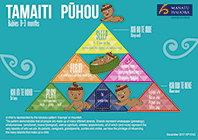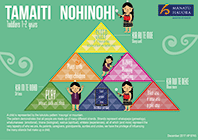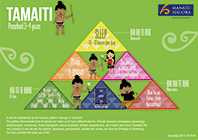Summary
These resources were developed to support the Sit Less, Move More, Sleep Well: Active play guidelines for under-fives.
The resources were designed predominantly for kaiako in kohanga reo, but can be used by any early childhood educators, regional sports trusts and others who provide advice to parents, caregivers and whānau on active play for tamariki under five years of age.
The resources consist of:
- four infographic posters
- two videos based on the movements of pūngāwerewere and mokomoko
- an oriori (sleep lullaby)
- a waiata
- a karakia.
Infographic posters
These infographic posters outline the importance of limiting and reducing the amount of time spent sitting. They encourage moving more throughout the day through regular play, and ensuring tamariki under five get the appropriate amount of sleep for their age.
In these posters, the child is represented by the tukutuku pattern ‘maunga’ (mountain). The pattern demonstrates that all people are made up of many different strands, with each strand representing who we are. The strands represent whakapapa (genealogy), whatumanawa (emotional), tinana (biological), wairua (spiritual), whēako (experiences). Kaiako, parents, caregivers, grandparents, aunties, uncles and whānau all have the ability to influence the strands that make up the child.
The infographic posters can be displayed in kohanga reo, early childhood centres, GP practices and other healthcare establishments and include:
Pūngāwerewere and mokomoko videos
The following videos are based on He Pī Ka Rere, Toi Tangata’s under-fives movement programme run through kohanga reo. He Pī Ka Rere uses the traditional movements of pūngāwerewere (spiders) and mokomoko (lizards) to inspire tamariki to be active.
Watch the videos:
Video title: Sit Less, Move More, Sleep Well: Pungawerewere
[Maia sits at the top of the slide in the school playground]
Kia ora koutou ko MAIA ahau!
My name is MAIA and we are going to explore how we can move like Kaitiaki or guardians.
We are going to explore the ngahere or forest which is the realm of Tāne Mahuta to find a connection to movement through some of his descendants.
Who is Tāne you might be thinking?
[Graphic showing the different things Tāne is the lord of]
Tāne or Tāne mahuta is lord of the forest and all its creatures, in particular birds, lizards, insects and trees.
[Maia is in the forest]
Now that we know who Tāne is let's start by acknowledging Tāne through a karakia.
[Words to the karakia appear on the screen]
Whāia, whāia, whāia te uru tapu nui a Tāne, Tāne te Wānanga, Tāne te toko i te rangi, Tāne te atua o te ngahere.
Haumi e, Hui e, Taiki e.
Now that we've acknowledged Tāne, let's see how one of his descendants - the pūngawerewere - moves.
[A pungawere (spider) climbs up the tree]
What is a Pūngawerewere?
Pūngawerewere are spiders.
In many stories in Te Ao Maori the Pūngawerewere was a guardian but there are many other stories the Pūngawerewere was also feared.
[A split screen shows Kimiora on the right and Werewere on the left]
My friends Kimiora and Were are going to show us how we might move like a Pūngawerewere.
Kia Ora kōrua!
Are you ready?
Ka pai!
Toru! Rua! Tahi!
Tīmata!!
[Kimiora and Werewere move like spiders]
Kia kaha! Whakamuri!
Ka rawe!
Well done!
[Maia is back in the school playground]
And thats how you move like a Pūngawerewere!
Kakite!
Video title: Sit Less, Move More, Sleep Well: Mokomoko
[Maia sits at the top of the slide in the school playground]
Kia ora koutou ko MAIA ahau!
My name is MAIA and we are going to explore how we can move like Kaitiaki or guardians.
We are going to explore the ngahere or forest which is the realm of Tāne Mahuta to find a connection to movement through some of his descendants.
Who is Tāne you might be thinking?
[Graphic showing the different things Tāne is the lord of]
Tāne or Tāne mahuta is lord of the forest and all its creatures, in particular of birds, lizards, insects and trees.
[Maia is in the forest]
Now that we know who Tāne is let's start by acknowledging Tāne through karakia.
[Words to the karakia appear on the screen]
Whāia, whāia, whāia te uru tapu nui a Tāne, Tāne te Wānanga, Tāne te toko i te rangi, Tāne te atua o te ngahere.
Haumi e, Hui e, Taiki e.
Now that we've acknowledged Tāne, let's see how one of his descendants - the mokomoko moves.
[A mokomoko (lizard) climbs up the tree]
What is a mokomoko?
Mokomoko are lizards.
In many stories in Te Ao Maori the Mokomoko was a guardian but there are many other stories the Mokomoko was also feared.
[A split screen shows Kimiora on the right and Moko on the left]
My friends Kimiora and Moko are going to show us how we might move like a Mokomoko.
Kia Ora kōrua!
Are you ready?
Ka Pai!
Toru! Rua! Tahi!
Tīmata!!
[Kimiora and Moko move like lizards]
Whakamuri!
Kia kaha!
Whakamua!
Kia Kaha!
Ka rawe!
Well done!
[Maia is back in the school playground]
And that's how you move like a Mokomoko!
Kakite!
Mokomoko and pūngāwerewere movements can be used for games such as Simon says, races, and obstacle courses.
Kai tipu kai tope is a game often played with these movements.
One team are the kai tipu or planters. They must plant the seed for the tree or rakau to grow (by placing a cone, water bottle or similar upright). The other team are the kai tope who are chopping down the rakau (by knocking over the cone or bottle). Whilst playing the game participants can utilise mokomoko and pūngāwerewere movements.
Kaiako and parents could add variations to make the games more challenging.
Oriori – Huia Kaimanawa
This oriori (lullaby) was composed to align with the sleep well part of the Sit Less, Move More, Sleep Well: Active play guidelines for under-fives by nurturing and supporting moe (sleep).
The oriori can be played to children as they go to sleep.
Listen to the oriori: Huia Kaimanawa (3 mins, 19 secs):
Te Reo lyrics
E moehewa taku puipuiaki
E hōrapa ngā rangi takō
Ka huri whakaterāwhiti
Ko to aro, te whitinga o te rā
Ka huri whakateuru
Ko to aro, te tōnga o te rā
E hoka ana koe ki runga
Ki te āhuru mōwai
E rumaki ana koe i nga rangi tuhāhā
Ka rere atu koe ki te kohu i, to maunga rangatira e
Kia tau iho ra i te tihi
Ka kitea te whaanui mata o papa
Ka huri whakararo koe
Kia rere atu ki runga to whenua papatipu
Ka huri whakauta koe
Kia rere atu ki runga to whenua taurikura
E rere e rere e taku huia kaimanawa
English lyrics
Dream my precious
Explore the clear skies
Gaze eastward
There you will see the rising of the sun
Gaze westward
There you will see the setting of the sun
Soar on above
To a calm place
Immerse yourself within the sacred knowledge
Now fly onwards into the mists of your
chiefly mountain
Come to land at the peak
Where the mighty breadth of the earth can be seen
Then you turn and descend
Passing over your ancestral lands
Then you head inland
Passing over your prosperous lands
Fly, fly on my treasured one
- Download the oriori: Huia Kaimanawa (mp3, 7.5 MB)
- Download the oriori (Tāne voice): Huia Kaimanawa (mp3, 7.6 MB)
- Download the lyric sheet: Oriori (pdf, 4.2 MB)
Waiata – Te Rau Amokura
This waiata was composed to align with the move more well part of the Sit Less, Move More, Sleep Well: Active play guidelines for under-fives to acknowledge the importance of movement and play for tamariki.
Listen to the waiata: Te Rau Amokura (3 mins, 33 seconds):
Te Reo lyrics
(Chorus)
E te rau amokura
He rangatira mākoha nui
Kei taku piringa
Kei taku oranga
Kei taku pūmau
Kia piri, kia tata, kia nukunuku mai
(Verse 1)
He huakina mai
Tōku ngākau, mōhou
Kei roto i ahau, te hurō e raungaiti ana
Me āta pupuri kia mau, kia ita, kia kore ai e ngaro
(Chorus 2)
(Verse 2)
E kakapa kau ana
Tōku whatu manawa mōhou
Ko koe, te tau o taku ate
He piki kōtuku koe
Me āta pupuri kia mau, kia ita, kia kore ai e ngaro
(Chorus 3)
English lyrics
(Chorus)
Remarkable chief
A tranquil leader
My shelter
My livelihood
My permanence
Be close, be near,
but let your movements be frequent
(Verse 1)
My heart mind and soul is open for you
The joy within in me I can’t contain
Carefully grasped, held firm, so that you
will never be lost
(Chorus 2)
(Verse 2)
The seat of my emotions flutter for you
As you are the grace of my heart
You are the symbol of uniqueness
Be close, be near,
but let your movements be frequent
(Chorus 3)
- Download the waiata: Te Rau Amokura (mp3, 8.1 MB)
- Download the lyric sheet: Waiata (pdf, 2.8 MB)
Karakia – E Tipu E Rea
This karakia was composed to create a roadmap for tamariki to reach their potential as tangata. Within Te Ao Māori, the karakia is a mechanism to talk to the child about their future aspirations and adventures. The words of this karakia can be used by kaiako, parents, caregivers, grandparents, aunties and uncles in any setting.
- Download the lyric sheet: E Tipu E Rea (pdf, 8.5 MB)
HP numbers for resources
- Tamaiti pūhou (babies) 0 – 3 months: HP 6743
- Owhaowha (infants) 3 – 12 months: HP 6742
- Tamaiti nohinohi (toddlers) 1 – 2 years: HP 6745
- Tamaiti (preschool) 3 – 4 years: HP 6744
- Oriori: Huia Kaimanawa pdf: HP 6762
- Karakia: E Tipu E Rea pdf: HP 6763
- Waiata: Te Rau Amokura pdf: HP 6764




